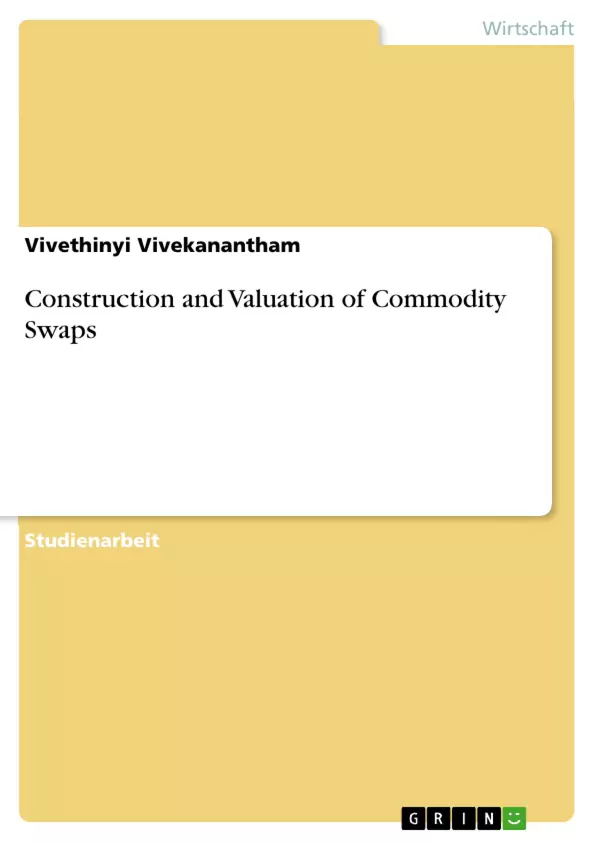The purpose of this research is to describe a special form of swaps: commodity swaps. Providing an overview of the application, construction and valuation of commodity swaps.
The organization of the research is structured in five chapters. The next chapter involves theoretical fundamentals of the terms commodity and swap and it defines the meaning of the expression commodity swap. After that, the paper outlines the main trading motives of commodity swaps. Then, two types of commodity swaps, which are the basis of a further modification of commodity swaps, are introduced and their construction is illustrated.
In addition to the construction, the following part starts with the theoretical valuation of commodity swaps and gives a fictive instance of a valuation. The paper closes with a conclusion of the main points of the construction and valuation of commodity swaps.
Inhaltsverzeichnis
- 1. Einführung
- 2. Theoretische Grundlagen
- 2.1. Rohstoff
- 2.2. Swap
- 2.3. Rohstoff Swap
- 3. Konstruktion von Rohstoff Swaps
- 3.1. Handelsmotive
- 3.2. Arten von Rohstoff Swaps
- 3.2.1. Fest-Float Rohstoff Swaps
- 3.2.2. Rohstoff gegen Zins Swaps
- 4. Bewertung von Rohstoff Swaps
- 4.1. Bewertungsmethoden
- 4.2. Bewertung eines Rohöl-Rohstoff Swaps
Zielsetzung und Themenschwerpunkte
Diese Arbeit befasst sich mit der Konstruktion und Bewertung von Rohstoff Swaps. Ziel ist es, ein umfassendes Verständnis der zugrundeliegenden Mechanismen und Bewertungsmethoden zu vermitteln.
- Definition und Charakteristika von Rohstoff Swaps
- Konstruktionsmerkmale verschiedener Swap-Typen
- Handelsmotive und Anwendungsfälle
- Methoden zur Bewertung von Rohstoff Swaps
- Anwendungsbeispiel: Bewertung eines Rohöl-Rohstoff Swaps
Zusammenfassung der Kapitel
1. Einführung: Dieses Kapitel dient als Einleitung in die Thematik der Rohstoff Swaps und liefert einen Überblick über den Aufbau der Arbeit.
2. Theoretische Grundlagen: Dieses Kapitel legt die theoretischen Grundlagen für das Verständnis von Rohstoff Swaps. Es definiert den Begriff "Rohstoff" und erläutert die Funktionsweise von Swaps im Allgemeinen, bevor es sich auf die spezifischen Eigenschaften von Rohstoff Swaps konzentriert. Es bildet die essentielle Basis für die folgenden Kapitel, indem es die notwendigen Konzepte und Definitionen bereitstellt.
3. Konstruktion von Rohstoff Swaps: Dieses Kapitel befasst sich mit der Konstruktion von Rohstoff Swaps. Es analysiert die Handelsmotive, die Unternehmen zum Abschluss solcher Geschäfte bewegen, und beschreibt verschiedene Arten von Rohstoff Swaps, darunter Fest-Float und Rohstoff-gegen-Zins Swaps. Die detaillierte Erläuterung der verschiedenen Swap-Typen und ihrer jeweiligen Konstruktion ist essentiell für das Verständnis der späteren Bewertungsmethoden.
4. Bewertung von Rohstoff Swaps: Dieses Kapitel konzentriert sich auf die Bewertung von Rohstoff Swaps. Es beschreibt die Methoden zur Bewertung und präsentiert ein konkretes Beispiel für die Bewertung eines Rohöl-Rohstoff Swaps. Die detaillierte Darstellung der Bewertungsmethoden, inklusive eines konkreten Beispiels, macht dieses Kapitel zu einem zentralen Bestandteil der Arbeit und verdeutlicht die praktische Anwendung der theoretischen Grundlagen.
Schlüsselwörter
Rohstoff Swaps, Bewertung, Konstruktion, Handelsmotive, Rohöl, Fest-Float Swap, Rohstoff gegen Zins Swap, Bewertungsmethoden.
Häufig gestellte Fragen (FAQ) zu "Konstruktion und Bewertung von Rohstoff Swaps"
Was ist der Inhalt dieser Arbeit?
Diese Arbeit bietet einen umfassenden Überblick über die Konstruktion und Bewertung von Rohstoff Swaps. Sie beinhaltet eine Einführung, theoretische Grundlagen zu Rohstoffen und Swaps, eine detaillierte Analyse der Konstruktion verschiedener Swap-Typen (inkl. Handelsmotive), und schließlich Methoden zur Bewertung von Rohstoff Swaps mit einem konkreten Beispiel für einen Rohöl-Rohstoff Swap.
Welche Themen werden im Einzelnen behandelt?
Die Arbeit deckt folgende Themen ab: Definition und Charakteristika von Rohstoff Swaps, Konstruktionsmerkmale verschiedener Swap-Typen (z.B. Fest-Float und Rohstoff gegen Zins Swaps), Handelsmotive und Anwendungsfälle, Methoden zur Bewertung von Rohstoff Swaps, und ein Anwendungsbeispiel: die Bewertung eines Rohöl-Rohstoff Swaps.
Welche Kapitel umfasst die Arbeit und worum geht es in jedem Kapitel?
Die Arbeit gliedert sich in vier Kapitel: Kapitel 1 (Einführung) dient als Einleitung. Kapitel 2 (Theoretische Grundlagen) definiert Rohstoffe und Swaps und legt die Basis für das Verständnis von Rohstoff Swaps. Kapitel 3 (Konstruktion von Rohstoff Swaps) analysiert Handelsmotive und verschiedene Swap-Typen. Kapitel 4 (Bewertung von Rohstoff Swaps) beschreibt Bewertungsmethoden und präsentiert ein Beispiel zur Bewertung eines Rohöl-Rohstoff Swaps.
Welche Arten von Rohstoff Swaps werden behandelt?
Die Arbeit behandelt verschiedene Arten von Rohstoff Swaps, darunter explizit Fest-Float Rohstoff Swaps und Rohstoff gegen Zins Swaps. Die detaillierte Erläuterung ihrer Konstruktion ist ein zentraler Bestandteil.
Wie werden Rohstoff Swaps bewertet?
Die Arbeit beschreibt verschiedene Methoden zur Bewertung von Rohstoff Swaps. Ein konkretes Beispiel für die Bewertung eines Rohöl-Rohstoff Swaps wird detailliert erläutert, um die praktische Anwendung der Bewertungsmethoden zu veranschaulichen.
Welche Schlüsselwörter beschreiben den Inhalt der Arbeit am besten?
Schlüsselwörter sind: Rohstoff Swaps, Bewertung, Konstruktion, Handelsmotive, Rohöl, Fest-Float Swap, Rohstoff gegen Zins Swap, Bewertungsmethoden.
Was ist das Ziel der Arbeit?
Das Ziel der Arbeit ist es, ein umfassendes Verständnis der zugrundeliegenden Mechanismen und Bewertungsmethoden von Rohstoff Swaps zu vermitteln.
Für wen ist diese Arbeit relevant?
Diese Arbeit ist relevant für Studierende, Wissenschaftler und Praktiker, die sich mit Finanzmärkten, Rohstoffen und Derivaten auseinandersetzen. Sie bietet einen fundierten Einblick in die Theorie und Praxis von Rohstoff Swaps.
- Citar trabajo
- Vivethinyi Vivekanantham (Autor), 2017, Construction and Valuation of Commodity Swaps, Múnich, GRIN Verlag, https://www.grin.com/document/509899



